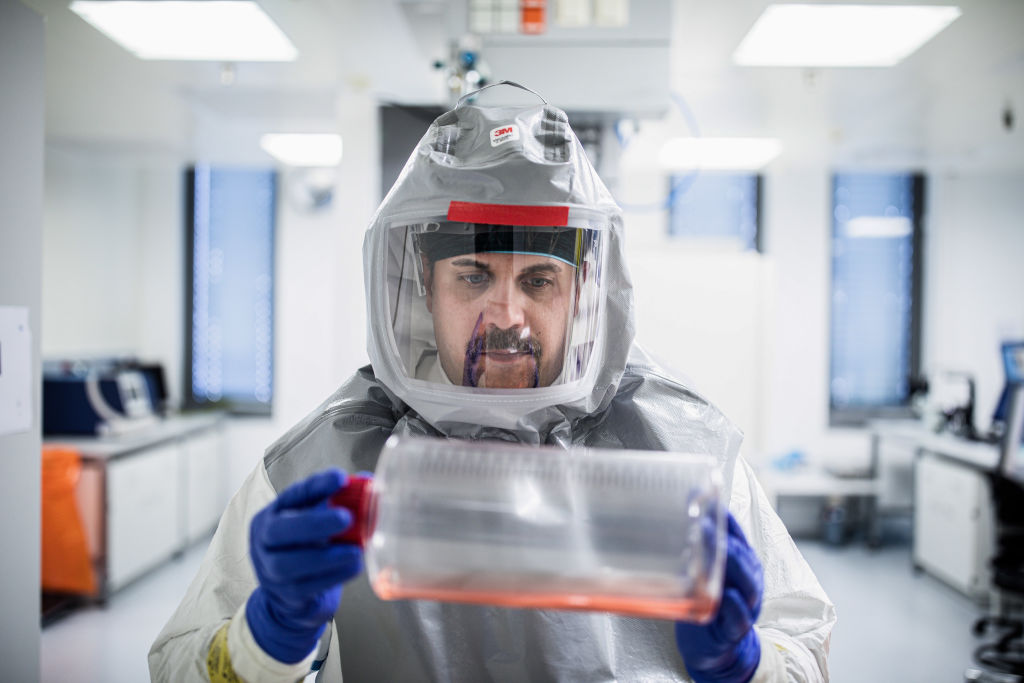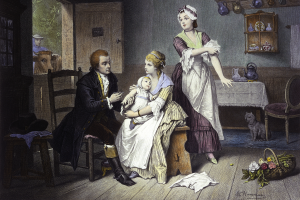COVID-19
On the Cusp of a Vaccine—and a Historic Scientific Triumph
What is unique about our time is not “the awful spectacle of men dying like sheep,” as Thucydides put it, but the success of scientists in bringing many such spectacles to an end.

More than a century separated the first wave of Spanish flu in 1918 from the emergence of COVID-19 in early 2020. Yet as Nicholas Christakis writes in his new book, Apollo’s Arrow: The Profound and Enduring Impact of Coronavirus on the Way We Live, there are people who’ve been laid low by both plagues, and even lived to tell the tale.
These include Marilee Harris, who caught the Spanish flu as a six-year-old child in Chicago. She survived, then a century passed—during which time she became a sculptor, got married (twice), wrote a book about her life, and moved to Washington, DC, where, still a working artist at age 107, she was hospitalized with COVID-19. Doctors called her daughter with the grave news that she only had hours to live. (The COVID-19 death rate for those aged 85 and over is estimated to be 630 times higher than for young adults.) Amazingly, she survived, went home, and lived another five months before passing away on September 11th.
As Christakis shows, there are some aspects of plagues that remain timeless. In 1918, as in 2020, much of our fate is dictated by luck. There are young marathon runners and bodybuilders who find themselves on ventilators within days of contracting COVID-19, while some pack-a-day smokers somehow escape with only mild symptoms. Historical examples described in Apollo’s Arrow also show that we are not the first society to fall into the grips of profound malaise when ravaged by plague. During the Plague of Athens 25 centuries ago, Thucydides observed in Book Two of his History of the Peloponnesian War that:
by far the most terrible feature in the malady was the dejection which ensued when anyone felt himself sickening, for the despair into which they instantly fell took away their power of resistance, and left them a much easier prey to the disorder; besides which, there was the awful spectacle of men dying like sheep, through having caught the infection in nursing each other. This caused the greatest mortality. On the one hand, if they were afraid to visit each other, they perished from neglect; indeed, many houses were emptied of their inmates for want of a nurse: On the other, if they ventured to do so, death was the consequence.
It wasn’t until the 1860s that Louis Pasteur crucially advanced the germ theory of disease—a singularly important tool for those formulating effective public-health measures—by demonstrating (among many other valuable discoveries) that the spoilage of milk was caused by pathogens in the air. But even if doctors now had a better understanding of how diseases spread, they often lacked the technologies to save their patients. In 1912, the year of Harris’s birth, the average American life expectancy was about 53 years, not so different from peaceful societies in the Middle Ages. Not until the 1930s would it go above 60. And not until the 1960s would it go above 70.
Not only did Western societies become more technologically advanced during the 20th century, they also became wealthier, thereby allowing the construction and operation of advanced hospitals staffed by legions of trained health professionals. In her autobiography, Harris described how she “was born in Aunt Annie’s room [at home] because my mother didn’t want to mess up her father’s bed.” When she contracted Spanish flu as a six-year-old, she simply went to her room to wait it out, there to live or die. (The Spanish flu, unlike COVID-19 was deadly to small children. And as Christakis recounts, Harris only knew she’d really cheated death when she finally walked down the stairs to see her father eating breakfast, a sight she still remembered a century later.) In 2020, by contrast, hospitals typically go to extraordinary lengths to prolong the lives of even the most elderly patients, and the idea of a small child facing a potentially fatal illness alone, at home, without proper medical attention, would be unthinkable.

Edward Jenner vaccinating his child
The very first vaccine, for smallpox, was developed in 1796 by Edward Jenner, an English country doctor who noticed that milkmaids seemed to exhibit a unique resistance to the disease. He theorized, correctly, that this had something to do with their day-to-day exposure to cowpox, a related but far more innocuous disease (in humans). Applying a product testing regime that would horrify modern ethics committees, Jenner deliberately infected his gardener’s eight-year-old son with fluid from a cowpox blister, after which he exposed the boy to powdered smallpox scabs. When he observed that no disease developed, the world was set on its way to ridding itself of the disease.
The latter part of the 20th century proved a “golden era” for the development of vaccines that protect us from diseases such as polio, measles, mumps, rubella, and hepatitis B. But the pace of development has since slowed. Some diseases, such as HIV, hepatitis C, and Ebola have remained stubbornly resistant to vaccine treatment. Nor do we have vaccines for SARS or MERS, a potentially ominous shortcoming given that these zoonotic coronaviruses share general properties with SARS-CoV-2, the virus that causes COVID-19.
As Australian virologist Gregory Tannock and his co-authors noted recently in the Journal of Medical Virology, bottlenecks in the vaccine pipeline can be traced to the interplay of a number of economic, legal and regulatory factors. “Research on human vaccines… is usually undertaken by smaller commercial enterprises associated with research institutes,” the authors note. “By contrast, commercial manufacture in first world countries is confined to a decreasing number of very large multinational companies… The decreasing numbers of commercial manufacturers have been driven, in part, by the need to achieve economies of scale in the manufacture and by an increase in testing requirements before vaccine release that have been underpinned by codes of good manufacturing, laboratory, and clinical practice.”
That article was published in February 2020, just as COVID-19 (which isn’t mentioned by the authors) was bursting out of China. And in the nine months that have passed since its publication, we have been able to observe how the slow pace of pharmaceutical science may be drastically accelerated when it is funded generously by governments and freed from normal regulatory constraints. This month, corporate partnerships led by Pfizer and Moderna announced extraordinary preliminary results in regard to their candidate COVID-19 vaccines, both of which were shown to provide about 95 percent protection levels in placebo-controlled tests involving tens of thousands of people.
Many further challenges may emerge. And the announced results have not yet been peer reviewed. But as things stand, it now seems reasonable to hope that millions of people—perhaps tens of millions—will be vaccinated against COVID-19 before the year is over. While the corporate language used to announce this good news is dry and lawyerly (“Moderna’s COVID-19 Vaccine Candidate Meets its Primary Efficacy Endpoint in the First Interim Analysis of the Phase 3 COVE Study”), the humanitarian upshot is staggering.
Moreover, as former Harvard Medical School dean Jeffrey Flier noted recently in Quillette, the Pfizer and Moderna vaccines are just two candidates among dozens being tracked by the World Health Organization (about a quarter of which are in late-stage clinical trials). And since all of these projects are targeting a common component of the virus structure—its spike protein, which has now shown itself to be a viable target—there is a real prospect that multiple vaccines will come online, from different production facilities, in different parts of the world.

As recently as just a few weeks ago, it seemed possible that our societies would persist in a fearful, politically agitated, economically depressed state for many months, or perhaps even years, cycling between periods of lockdown and release according to the vagaries of infection. Now, thanks to the same pharma companies that often come in for political attack (from both sides of the spectrum), there is real light at the end of the tunnel. Though it is still early days, we really do stand on the cusp of what could be one of the greatest scientific achievements of our time.
So far, the human face of this miracle-in-the-making has been provided by the workaholic Turkish-German husband-and-wife team of Ugur Sahin and Özlem Türeci, the BioNTech founders who developed the candidate vaccine that Pfizer could soon be producing in mass quantities. But there is also a larger story here involving mRNA (messenger RNA), the novel technological basis for both the Pfizer and Moderna candidate vaccines. For years, administered mRNA sequences had been seen as a promising means of stimulating the production of proteins or pathogen antigens within human cells, but had never delivered a single approved vaccine or drug. That may now change, and in the most dramatic context imaginable.
Unlike traditional vaccines, mRNA-based candidate vaccines don’t contain antigens, or viruses. Instead, they contain an RNA fragment that can serve to reprogram our cells to take on certain characteristics of a pathogen. In humans, as in other creatures, mRNA is a communications medium used within the body to tell cells which proteins to produce. Through mRNA, a drug treatment can co-opt aspects of a body’s internal command and control systems.
In the case of the candidate mRNA-based vaccines that would protect us against SARS-CoV-2, our cells would be instructed to build replicas of the spike protein that SARS-CoV-2 uses as a pathway into our bodies. When this molecular process is successful—as was apparently the case for at least 90 percent of the individuals who received the Pfizer and Moderna candidate vaccines—these spike-protein outcroppings attract the attention of the immune system, which reacts by producing customized antibodies. In this way, the system is conditioned to respond quickly and aggressively if the spike protein of a real SARS-CoV-2 pathogen presents itself (though, at this early stage, the duration of the protective effect is still an open question).
As a recent report in Stat notes, this is just one example of a technology with almost limitless medical potential. (As author Damian Garde describes it, “any cell in the body could be transformed into an on-demand drug factory.”) And its development comes with its own multicultural cast of heroes, including Hungarian-born mRNA researcher Katalin Karikó, who now oversees research in the field at BioNTech; immunologist Drew Weissman, who helped Karikó figure out how to smuggle mRNA into a cell without prematurely triggering the immune system; and the corps of far-sighted investors and experts who helped shepherd Karikó and Weissman’s early discoveries, and the work of Moderna’s scientists, into a viable business form. This inspiring narrative reminds us that the profit-driven corporations that create our machines and medicines, for all their widely reported flaws and scandals, are capable of truly extraordinary feats of technological genius—especially when, as now, their operations are financially turbocharged by government. (While Pfizer didn’t take US government funds to develop its vaccine candidate, it did join Moderna, Novavax, Johnson & Johnson, AstraZeneca, Sanofi, and GlaxoSmithKline in pre-arranged supply agreements with governments that would ensure these companies receive pre-arranged prices for any approved vaccines.)
* * *
This is not a simple morality play of Western scientists and political leaders saving the world from a global pandemic. As Christakis argues in Apollo’s Arrow, we can learn plenty from the Chinese, whose rapid shutdown of public life among 934 million people in late January (albeit following a period of unconscionable inaction and, in some cases, public lies) ranks as “the largest imposition of public health measures in human history.” By late March, he notes, “the number of new reported cases in the nation dropped from thousands per day to less than fifty… By April, the daily case count hit zero.” Even if China’s reported COVID-19 death count of 4,634 is off by a geometric factor of five due to misreporting, it’s still a tenth that of the United States (which stands at 248,000 and climbing), and in a country four times as populous. (For a complete treatment of China’s role in regard to the rise, spread, and suppression of COVID-19, please see Philippe Lemoine’s lengthy Quillette series on the subject, published in August.)
This in itself does not constitute a defense or vindication of China’s authoritarian form of government. But it does show that America’s decentralized style of politics and low level of social trust have serious—and in some cases potentially apocalyptic—drawbacks. Certainly, it is hard to argue with Christakis’s conclusion that our post-pandemic politics may be affected by the realization that “strong, coordinated state action” sometimes is necessary.
But perhaps the most important silver lining to emerge from the pandemic would be a reversal of what Christakis rightly identifies as the “denigration of science” and even “the fundamental idea that it is possible to have an objective appreciation of the truth.”
While researchers toiled anonymously to provide us with a COVID-19 vaccine, much of the society around them degenerated into pseudoscientific babble centered around quack remedies and conspiracy theories. Some conservatives cited spurious reasons to reject mask usage in public spaces, while radicalized progressives argued (ludicrously) that mass demonstrations in the name of fashionable political causes somehow didn’t constitute a threat to public health. One might hope that the good news from Moderna and Pfizer, whose life-saving accomplishments rest on real, objective principles of human molecular biology, would humble both sides.
In 2018, Canadian-American cognitive scientist Steven Pinker published Enlightenment Now: The Case for Reason, Science, Humanism, and Progress, whose sunny thesis about the roots of modern progress proved surprisingly controversial. A year after its publication, he reflected in Quillette about the many critics who insisted that the Western intellectual tradition has yielded little but “racism, imperialism, existential threats, and epidemics of loneliness, depression, and suicide.”
For those truly dedicated to the task of saddling our intellectual and scientific heroes with the sum of human evil, nothing we write here will dissuade them. But surely, one thing that can’t be laid at our civilization’s feet is the existence of pathogens and the plagues they cause. From the dawn of recorded history, pandemics have laid waste to cities, hamlets, and farms, robbed parents of children, and turned babes into orphans. What is unique about our time is not “the awful spectacle of men dying like sheep,” as Thucydides put it, but the success of scientists in bringing many such spectacles to an end.
Less than a year after COVID-19 was first identified, laboratories already are churning out prototypes of drugs that might not only help us put an end to the disease’s deadly ravages, but perhaps even wipe it off the face of the planet entirely, as our ancestors did with smallpox. While it would certainly be premature for anyone to declare that COVID-19 has been defeated, it isn’t too early to take inspiration from the scientists who’ve brought us to victory’s doorstep.
Featured image: A lab technician wearing a full body protection suit inspects a bottle containing growth media for virus production during coronavirus vaccine research at the Valneva SA laboratories in Vienna, Austria, on Thursday, Aug. 6, 2020. Akos Stiller/Bloomberg via Getty Images






